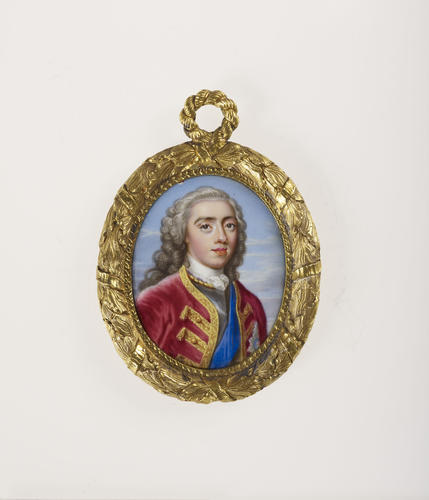-
1 of 253523 objects
William, Prince of Orange (1711-1751) 1734
Enamel | 3.2 x 2.6 cm (sight) (sight) | RCIN 421817
-
This portrait miniature was clearly painted from life by the artist, Christian Frederick Zincke. The Prince of Orange is wearing the ribbon and star of the Order of the Garter over a steel cuirass (a piece of body armour). It may be slightly flattering as William was not regarded as particularly handsome, but Horace Walpole, art historian and writer, commented: 'I have seen many worse figures: his face was good'.
William IV, Prince of Orange, arrived in England in 1734 for his marriage to Anne, Princess Royal, eldest daughter of King George II and Queen Caroline. His health was not good so he went to Bath to take the waters for a few weeks, and they were married on 14 March in the Chapel Royal adjoining St James's Palace. Lord Hervey, who oversaw the arrangements for the marriage, reported in his Memoirs that Anne's response to the news of her bridegroom's arrival was to continue playing her harpsichord as if nothing of significance had happened.
The artist, Christian Frederick Zincke (1683/4-1767), was born in Dresden, the son of a goldsmith. He settled in England in 1706 and studied enamel painting under Charles Boit. Boit was Enamel Painter to the Court until Queen Anne died in 1714 when he moved to France and Zincke took over much of his work. Zincke developed a thriving business, at first copying portraits by Sir Peter Lely and Sir Godfrey Kneller, then painting from life. He worked extensively for the royal family and, perhaps because he spoke German, was one of the few artists George II could tolerate. By 1730 he was well established at court and in February 1732, was appointed Cabinet Painter to Frederick, Prince of Wales, George II's eldest son. His eyesight began to fail, however, and he lamented: 'I find my Eyes scarce Capable of seeing them fine strokes'. By 1752 he had retired and only painted for his own pleasure. George II commented that Zincke's portraits were 'beautiful and like'.
Provenance
Probably commissioned in 1734 and in the Royal Collection ever since; first certainly recorded in 1858
-
Creator(s)
-
Medium and techniques
Enamel
Measurements
3.2 x 2.6 cm (sight) (sight)
4.6 x 4.1 cm (frame, external)
Category
Object type(s)
